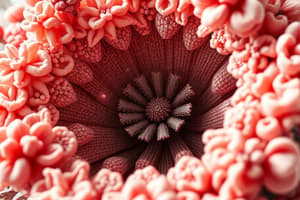Podcast
Questions and Answers
What does the phrase 'form follows function' imply in architecture?
What does the phrase 'form follows function' imply in architecture?
- Buildings should be aesthetically pleasing.
- Function should be prioritized over safety.
- Buildings should support activities inside them. (correct)
- All buildings should have the same structure.
Which of the following is NOT a characteristic of eukaryotic cells?
Which of the following is NOT a characteristic of eukaryotic cells?
- Membrane-bound organelles.
- Membrane-bound nucleus.
- No defined nucleus. (correct)
- Rod-shaped chromosomes.
What function do organelles serve in eukaryotic cells?
What function do organelles serve in eukaryotic cells?
- They provide structural support only.
- They compartmentalize different cellular functions. (correct)
- They convert energy from sunlight.
- They are responsible for cellular reproduction.
How do eukaryotic cells differ from prokaryotic cells?
How do eukaryotic cells differ from prokaryotic cells?
What is meant by the term 'organelle'?
What is meant by the term 'organelle'?
Which of the following organelles is involved in energy production?
Which of the following organelles is involved in energy production?
What is a key feature of the plasma membrane in eukaryotic cells?
What is a key feature of the plasma membrane in eukaryotic cells?
Which component of the cell is directly involved in the synthesis of proteins?
Which component of the cell is directly involved in the synthesis of proteins?
Study Notes
Philosophy of "Form Follows Function"
- Concept emphasizes that design reflects purpose, utilized in various industries, including architecture and biology.
- In architecture, buildings are designed to support specific activities, e.g., skyscrapers include multiple elevator banks and hospitals have accessible emergency rooms.
Eukaryotic vs. Prokaryotic Cells
- Eukaryotic cells contrast with prokaryotic cells by featuring a membrane-bound nucleus, allowing for compartmentalization of genetic material.
- Organelles in eukaryotic cells, such as endoplasmic reticulum, Golgi apparatus, chloroplasts, and mitochondria, are specialized for specific cellular functions.
- The presence of rod-shaped chromosomes in eukaryotic cells signifies a more complex organization and genetic structure.
Structure of Eukaryotic Cells
- Eukaryotic cells are characterized by their "true nucleus," enclosed by a membrane, distinguishing them from prokaryotic cells.
- Organelles, referred to as "little organs," enable distinct cellular processes, enhancing the overall complexity and efficiency of cellular functions.
Key Cellular Components
- The plasma membrane and cytoplasm serve as essential components of eukaryotic cells, influencing cellular structure and function prior to examining organelles.
Studying That Suits You
Use AI to generate personalized quizzes and flashcards to suit your learning preferences.
Description
Explore the principle of 'Form Follows Function' in design across various fields, particularly architecture. Delve into the distinctions between eukaryotic and prokaryotic cells, focusing on their structures and functions. Understand how these concepts relate to design and biological organization.




